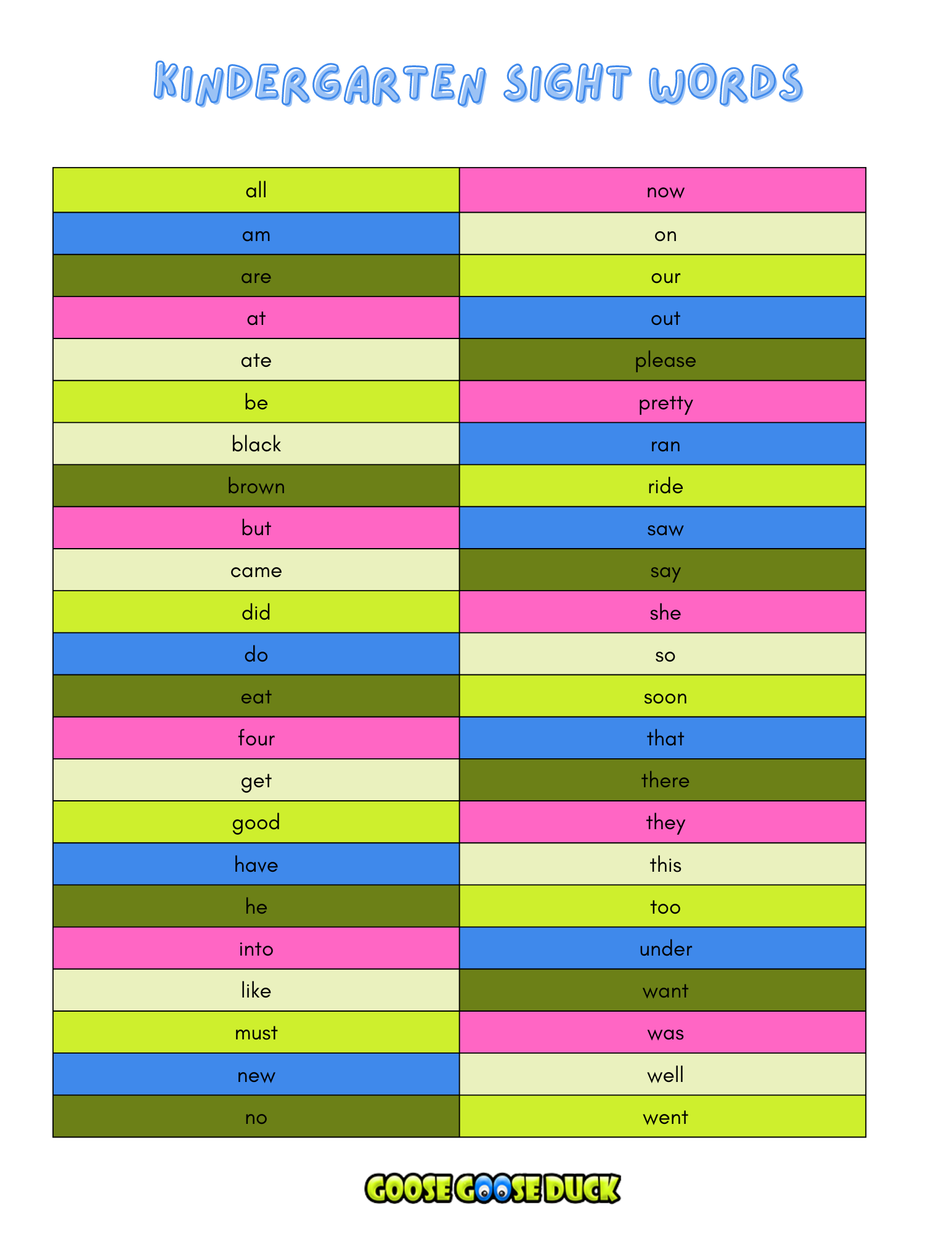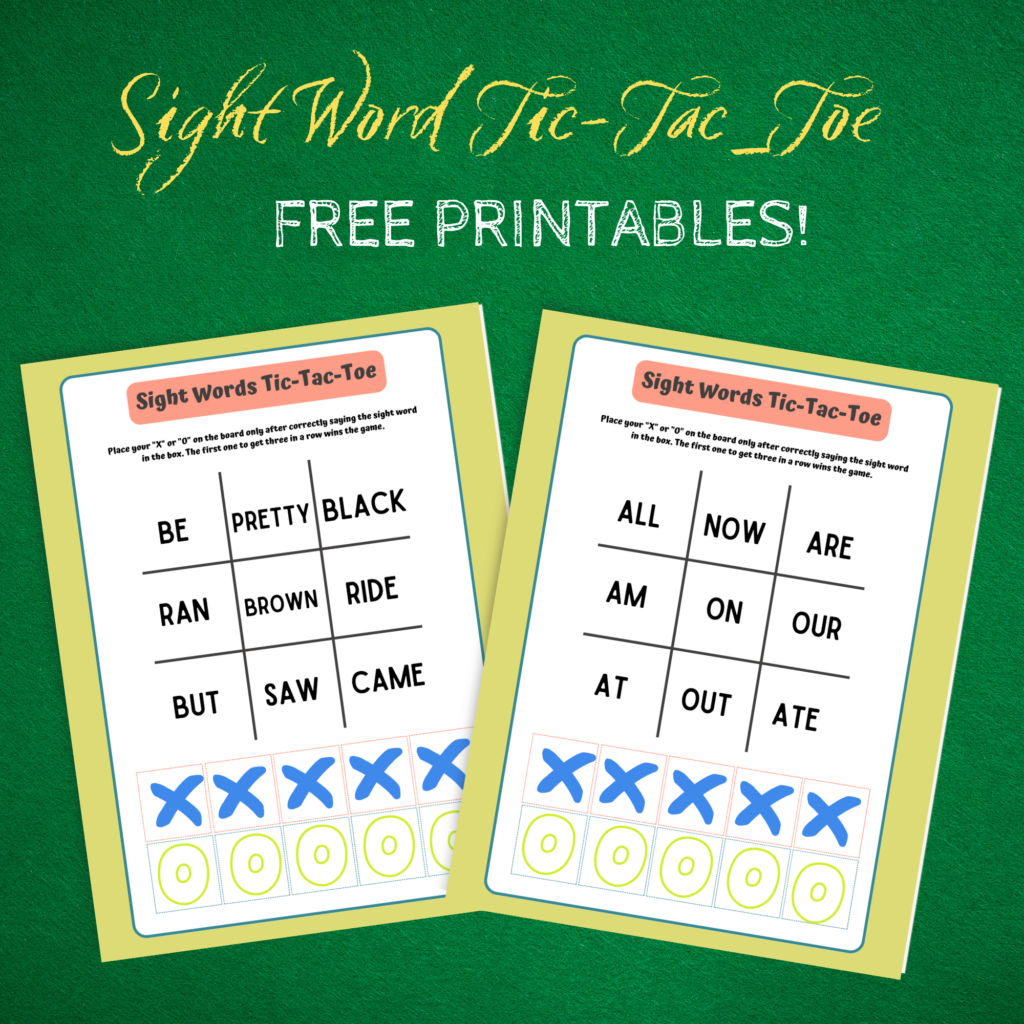Kindergarten Common Core Sight Words: 10 FUN ACTIVITIES [FREE PRINTABLES]
Are you struggling to make learning common core standards fun for your kids? Introducing Common Core standards to children can seem like a daunting task. However, there are many ways to make these standards fun and engaging while still teaching your kids the necessary information they need. With these activities focused on high-frequency words and common sight words, your children can gain valuable knowledge while having an enjoyable learning experience.
Sight words are commonly used in everyday language, and therefore are important to learn. Developing a familiarity with sight words helps young readers recognize them more easily in stories and other texts. Such recognition of these common terms leads to an increase in reading speed and fluency. Sight word memorization also allows students to focus on understanding what they’re reading instead of trying to sound out every single word they encounter.
Overall, learning sight words can help build confidence while providing the necessary foundation for successful literacy development in children. Knowing commonly used sight words makes it easier to understand longer, more complex texts later on down the road!

What is a Dolch Sight Word List?
The Dolch word lists is made up of 220 commonly used words that are important for young children to learn in order to read fluently. These words include nouns, pronouns, verbs, adverbs and adjectives. The purpose of this list is to provide children with an understanding of frequently used terms in the English language by providing them with visual recognition through memorization and repetition. Doing so helps them become more comfortable with reading and writing, while also improving their vocabulary skills.
Common Core Kindergarten Sight Words
In general, sight words are not required for kindergarten Common Core. However, it’s important to note that the Common Core standards focus on building students’ reading and writing skills in an incremental way. This means that while sight words may not be explicitly required, they can certainly help students build their reading fluency and comprehension skills.
A good approach is to introduce sight words gradually throughout the school year. This will give your child a chance to learn them at their own pace and become comfortable with them before moving on to more complex language tasks. Additionally, there are lots of fun games and activities you can do at home to help your child learn these words.
You learn with each child that every child learns differently and at different rates depending on the subject. With my oldest, she quickly learned all the sounds and was reading confidently by age four. However, phonics was not the best way of learning for my youngest. She quickly memorized the sounds of the letters just as she did math equations but struggled blending sounds together in the correct order. Sight words proved extremely helpful to build her confidence. She was able to effortlessly remember the sight words.
Teaching kids to read is an important task and one of the most effective methods is a combination of phonics and new sight words. Sight words are often referred to as “quick wins” due to their simplicity. A child can easily memorize these words, usually by repetition or association with pictures or stories. Phonics, on the other hand, teaches children how to decode unfamiliar words. This method helps children learn how letters are combined into syllables, which then form words. Through this approach, kids gain confidence in their ability to break down bigger challenges into small steps. By combining both methods, kids have access to the best of both worlds – quick wins with sight words and new ways of decoding through phonics. This encourages them to keep exploring different ways of reading while also helping build up their skill set so they can tackle more complex reading tasks independently.
What Are Sight Words?
Sight words are commonly used in everyday language and, therefore, are important to learn. Developing a familiarity with sight words helps young readers recognize them more easily in stories and other texts. Such recognition of these common terms leads to an increase in reading speed and fluency. Sight word memorization also allows students to focus on understanding what they’re reading instead of trying to sound out every single word they encounter.
Overall, learning sight words can help build confidence while providing the necessary foundation for successful literacy development in children. Knowing commonly used sight words makes it easier to understand longer, more complex texts later on down the road!
Sight Word Lists
Dolch kindergarten sight words are a collection of basic sight words which must be mastered by the end of kindergarten. Here is a complete list of the following words:

Teaching Sight Words
When it comes to teaching kindergarten students their sight words, repetition using daily activities is a great way to get them learning. Repetition helps kids remember new things and can make sight word practice more fun. Repetition helps children remember what they have learned and reinforces the content in a way that sticks with them. It also gives them the opportunity to practice what they have been taught and build on their knowledge over time. Additionally, when something is repeated often it becomes less intimidating for children as they become more familiar with it – making learning fun!
10 Kindergarten Sight Words Activities
With these ten activities, you can turn the learning process into an enjoyable game for everyone involved. Whether you’re looking for something hands-on or something that requires less mess, there’s sure to be an activity here that will help make the learning process easier and more enjoyable for both you and your little ones. Sight words are an essential part of any kindergartner’s education so why not have some fun with it? These activities are designed to help your children learn sight words in a way that is engaging and effective.
Go Fish: Sight Word Go Fish is a fun and easy way to practice sight words with your kids. Here’s how to play:
First, you’ll need a deck of cards with the sight words written on them. Don’t worry we have a free Sight Word Go Fish cards printable you can also use for sight word flash cards HERE. Once you have the cards, deal five to each player. Place the rest of the cards face down in the middle of the table.
The goal of the game is to collect as many sets of four matching sight words as possible. On each turn, players ask for a specific sight word from another player. If that player has it, they must give it up; if not, they say “Go Fish” and the first player draws from the pile in the middle. The first player to get four sets of matching sight words wins!
Stepping Stones: Place the word cards on the floor, making a fun stream going across the room. Have your child walk over the stream. As they step onto the stepping stone (word), have them say the word before they move on to get to the other side of the stream.
Word-O: This is played just like BINGO. Fill in a card with the words that you are working on. Make sure each card has a different set of words. Next, call out the words one by one and have the players mark off any words they see on their cards. The first player to get five in a row (horizontal, vertical, or diagonal) wins! You can also use special markers like chips or coins to mark off each word as you go along. The first one with a card covered calls out the word “WORD-O!” Finally, reward the winner with a prize or treat! This will encourage everyone to keep playing and learning new words.
Word Hunt: Look for target words in books or in the newspaper. Here’s a fun way you can play with books:
This game is a great way to make learning fun while reinforcing important literacy skills like recognizing sight words and understanding sentence structure. Have fun! If using the newspaper your child can highlight or circle the words that she finds.
Word Jump: Write the sight words onto the driveway. Call out a word. Have your child jump their way to the sight word.
Stair Chase: Place two sight word cards on each stair. Let them pick one sight word on the way up, saying the word and picking up the card when they read it correctly. Have them practice the other sight words on the way down.
Concentration: Create two sets of word cards. Place the word cards face down. Have your child turn over two cards, trying to make a match. Continue until all of the words are matched. You can use our free go fish printable found here for a quick set-up.
Chalk Writing: Writing sight words on the driveway with colorful chalk is a great way to help kids learn and practice their reading skills! It’s an easy, fun activity that can be done outdoors.
For younger kids, you can start by writing simple words and having them trace over it with their finger as they say the word out loud. As they get more comfortable with the words, you can have them write it themselves or even spell it out. You can also use this activity to introduce new sight words and challenge them to read longer sentences or stories.
Using colorful chalk adds an extra layer of fun for kids – they’ll love seeing the bright colors in their driveway!
Write Them Out: Use a wide variety of materials to practice writing sight words such as: Playdough, Stencils, Wiki sticks, Alphabet stamps, Scrabble tiles, Magnetic Letters, Legos, Popsicle Sticks, Salt on a Tray, Sidewalk Chalk, Sticks (in sand or dirt), Peanut Butter, Shaving Cream, Whipped Cream, Finger Paint, etc… the possibilities are endless. Get creative!
We also created free printable worksheets to help kids learn their sight words They include, coloring, tracing, finding and writing a simple sentence with each word. DOWNLOAD HERE
MORE RESOURCES
Here are a few more resources to help your young learners become better readers and enjoy the written word.
Phonics & Vowel Sound Posters
Are you looking for a way to reinforce vowel sounds and phonics in your homeschool or classroom? Visual displays are known to help students learn and retain information. Help your little learners with a consistent reminder of vowel sounds and phonics.
Here at Goose Goose Duck we have designed a variety of posters so children quickly recognize when they see a short vowel or long vowel! Our poster is colorful, eye-catching, and fun – perfect for helping young learners remember the basics of phonics. The best part is that it’s free – just download it here!
Goose Goose Duck Activity Pack
All the activities are designed for kindergarten aged children. With our exciting new resource, you’ll never look at American history or poetry the same way again.
Explore this unique opportunity to discover more about our country’s past while unlocking their inner poet. Take advantage of this one-of-a-kind learning experience today and get inspired by Gwendolyn Brooks’ timeless words! Try a free activity from this one of a kind activity pack here.




